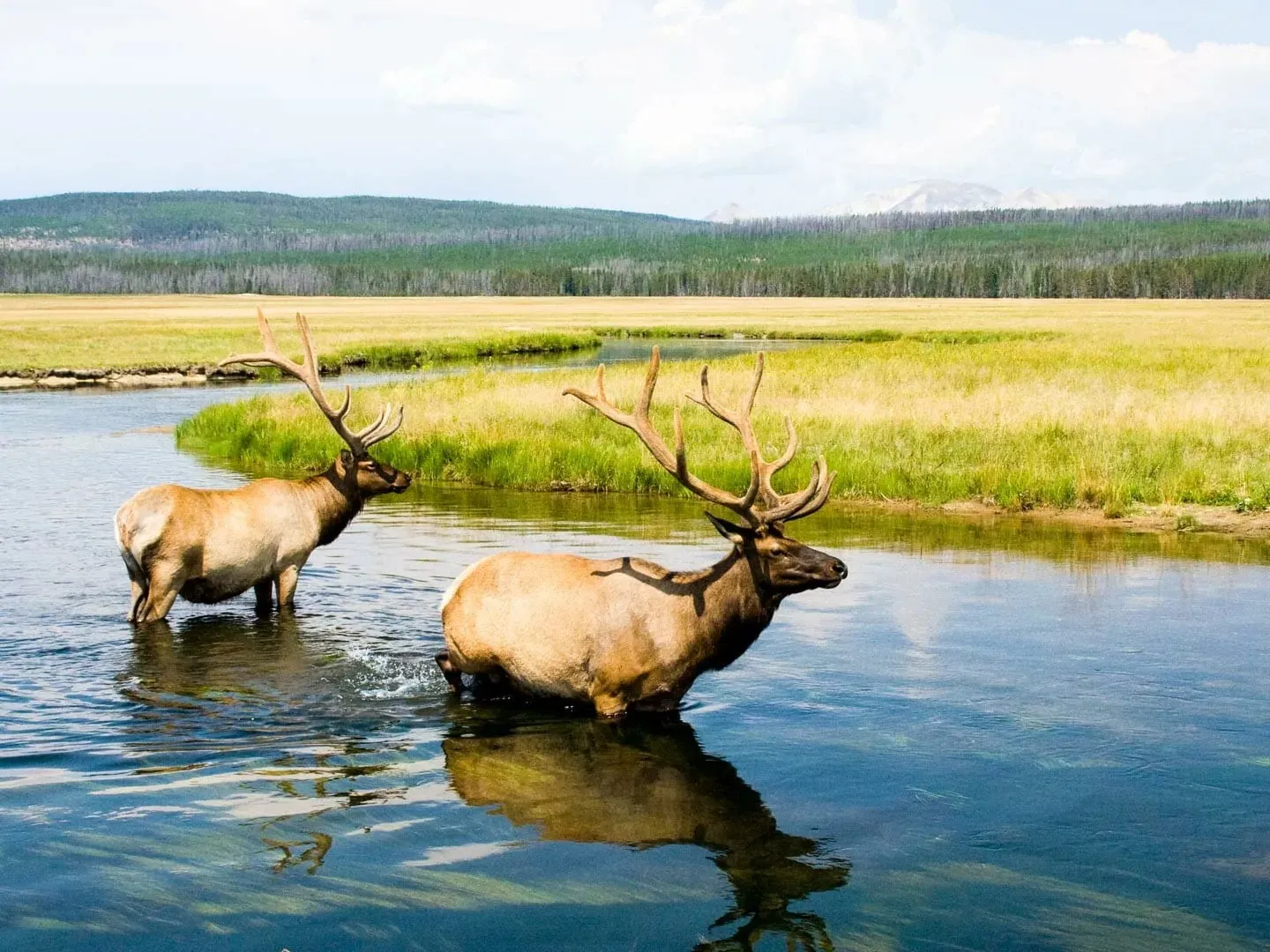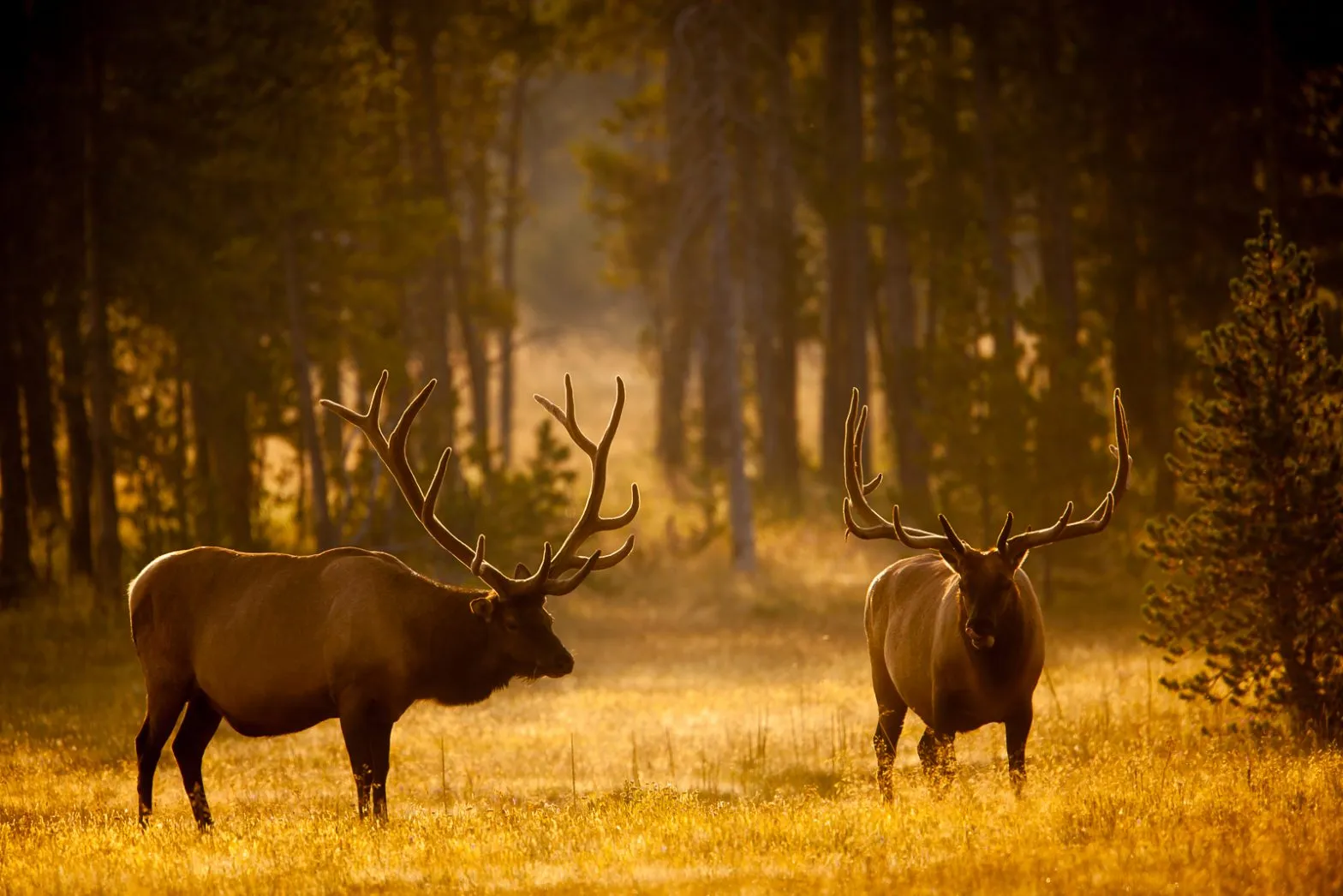Nestled within the vast and diverse landscapes of Yellowstone National Park, one of the most iconic and well-studied large mammals is the elk (Cervus canadensis). This majestic species, with its impressive antlers and robust physique, has long captivated the hearts and minds of both visitors and researchers alike.
The elk in Yellowstone National Park not only plays a crucial role in the park’s ecosystem but also serves as a living testament to the complex interplay between wildlife, habitat, and human management.
This article of nationalparkshops.com will delve into the life of the elk population in Yellowstone, exploring their behavioral patterns, ecological significance, and the challenges they face in the face of changing environmental conditions. From their migratory habits to their interactions with predators and other species, the story of the elk in Yellowstone National Park is a compelling narrative of survival and adaptation in one of America’s most treasured natural environments.
Overview of Elk in Yellowstone National Park
Elk are the most numerous large mammals in Yellowstone. European American settlers referred to this animal as “elk,” a term that in Europe refers to moose, which leads to confusion for visitors from Europe. Another name for elk comes from the Shawnee language, “wapiti,” meaning “white deer” or “white-rumped deer.” Some experts consider the North American elk to be the same species as Europe’s red deer (Cervus elaphus), but this remains a topic of taxonomic discussion. Most scientists currently classify North American elk as Cervus canadensis.
Due to their impressive antlers, bull elk rank among the most photographed animals in Yellowstone. They start growing their first set of antlers at about one year of age. The growth of antlers begins in spring, influenced by decreased testosterone levels and longer daylight hours. This change prompts the shedding of the previous year’s antlers, typically occurring in March and April, followed by new growth shortly thereafter.
Before the reintroduction of wolves in 1995, the elk in Yellowstone National Park had reached unsustainable levels, leading to significant damage to the park’s vegetation. However, with the return of wolves and other predators, the elk population has stabilized, allowing for a more balanced and thriving ecosystem.

Reproduction – Elk Rut
The elk mating season, known as the rut, starts in late August and early September. The haunting calls of bull elk resonate through the chilly autumn air, causing herds to gather into larger groups. Male elk vie for the chance to mate with a group of females, referred to as a harem. Observing and listening to the bulls’ eerie calls as they compete for position and protect their harems is one of the standout experiences of fall in Yellowstone.
You can hear a bull elk’s bugle, which ranges from deep grunts and low growls to high-pitched whistles.
Mammoth Hot Springs serves as the main hub for the elk rut. However, viewing them in the village can sometimes be crowded and chaotic. To see elk without large crowds, consider exploring Swan Lake Flats, Lamar Valley, and Madison Valley.
Although many people wish to witness a fight between bull elk, such occurrences are less frequent than one might expect. When the peak mating season arrives, the bulls establish a social hierarchy. Conflicts are uncommon because elk prefer not to get injured; they use vocalizations, body language, and scents to determine who is more dominant. If those methods fail to resolve the issue, they may engage in a head-to-head confrontation, which can be dangerous.
While witnessing the rut is thrilling, it’s crucial to remember that elk can be very aggressive and unpredictable during this period. It’s important to maintain the park’s required distance of at least 25 yards or more. You definitely want to avoid any encounters with an excited bull elk that could damage your car or injure you. Keep a safe distance, stay near (or inside) your vehicle, and enjoy observing them safely.
Elk Calves
The elk calving season generally starts when the park’s plants begin to flourish in May and June. The periods of high-nutrition vegetation enable mothers and their calves to accumulate fat reserves. At birth, calves are brown with white spots and emit little scent, which helps them blend in with their surroundings to avoid predators. They are capable of walking within an hour after being born but typically spend much of their first week to ten days resting in the sagebrush between feedings. Shortly thereafter, they start grazing alongside their mothers and become part of a group containing other cows and calves.
Facts about Elk in Yellowstone National Park Wildlife Guide
Physical Characteristics
Female elk can weigh as much as 500 pounds, while large male elk may reach weights of up to 700 pounds. An elk’s fur color varies from tan during summer to dark brown in winter. Their color becomes more intense around the legs, belly, head, and the shaggy mane that runs from the neck to the chest. Elk have a light-colored rear end and a short tail. They possess a robust body with long, thin legs, standing about 5 feet tall at the shoulder and measuring between 5 and nearly 9 feet from nose to tail.
Only male elk grow antlers, which they lose in March or April. New antlers start to develop shortly after the old ones are shed and can weigh up to 30 pounds for each pair! The distance between the tips of the antlers can reach 6 feet. During fights, males do not use their antlers to stab; instead, they interlock them and engage in wrestling, with the stronger male typically winning. These confrontations seldom lead to serious injuries.
Habitat & Feeding Habits
Elk in Yellowstone National Park primarily feed on grasses, sedges, and flowering plants during summer, while in winter, they consume woody plants like aspen and willows. They are classified as “ruminants,” meaning they chew cud and possess four-chambered stomachs. When they consume grasses and twigs, the material first enters the rumen, the first stomach chamber, where bacteria start to break down cellulose into digestible fatty acids. Elk then regurgitate this cud to re-chew it and swallow it again, allowing it to pass through the other stomach chambers where it is further digested by stomach acids, similar to how non-ruminants digest food.
This digestive process provides an advantage for ruminants, enabling them to quickly consume large quantities of food while vulnerable to predators and later digest it thoroughly in a safer location.
Prior to the return of wolves, elk overgrazed on willows and aspens to such an extent that these plants nearly vanished, which had drastic effects on various species and ecosystems.

Best Locations to View Elk in Yellowstone National Park
Yellowstone National Park offers numerous opportunities to observe elk in their natural habitat. Some of the best locations include:
- Mammoth Hot Springs: Located in the northern part of the park, Mammoth Hot Springs is a popular spot for elk viewing, particularly during the winter months.
- Lamar Valley: Known as one of the most wildlife-rich areas of the park, Lamar Valley is an excellent place to spot elk, as well as other large mammals like bison, bears, and wolves.
- Norris Junction: This area, located in the center of the park, is another great location for elk viewing, with the animals often grazing in the nearby meadows and valleys.
- Madison Junction: The Madison Junction area, situated in the western part of the park, is a prime spot for elk sightings, especially during the summer and fall.
- Grand Teton National Park: While not technically part of Yellowstone, Grand Teton National Park, located just to the south, is also home to a significant elk population. Visitors can spot elk along the Teton Park Road and in the Willow Flats area.
Remember, when viewing elk in Yellowstone National Park, it’s essential to maintain a safe distance of at least 25 yards, especially during the rut or around mothers with new calves. These animals are wild and can be unpredictable, so it’s crucial to respect their space and follow park guidelines for wildlife viewing.
Are you ready to show your love for the majestic elk and the breathtaking beauty of Yellowstone National Park?
Visit our store and explore our unique Yellowstone apparel collection! From striking moose-print t-shirts to cozy hoodies featuring the park’s stunning landscapes, we have everything you need to express your passion.
Each item is crafted with premium quality and beautiful designs, making them the perfect souvenirs for your unforgettable trip.
Check out [store link] today and bring a piece of Yellowstone home!


